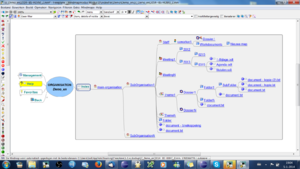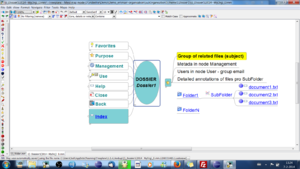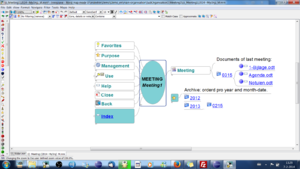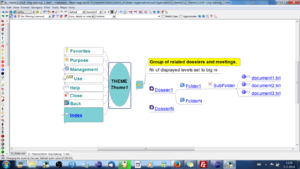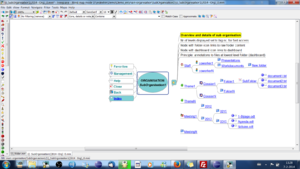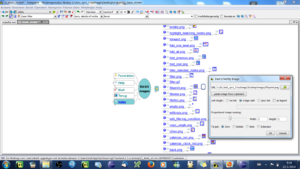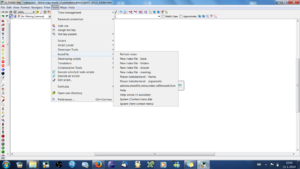Difference between revisions of "Information management withFreeplane add-on dView(indexfile)"
m (→Personal dashboard) |
m (Text replacement - "http://www.freeplane.org" to "https://www.freeplane.org") |
||
| (130 intermediate revisions by 2 users not shown) | |||
| Line 1: | Line 1: | ||
| − | = | + | =Introduction= |
| − | The add-on '' | + | The add-on ''dView(indexfile)'' supports adding annotations, hyperlinks and reminders to file names in a folder structure. For this a specialized dashboard mindmap must be put into the folder to index. When this dashboard is opened and button ''Index'' is pressed, a hierarchy of nodes with hyperlinks to the subfolders and files of the indexed folder is generated. Next one can add annotations, add hyperlinks to other files or websites, and add reminders (clock) for file related actions. If email adresses are registerd, with one click all users of a particular dashboard can be sent a group-email. The resulting mindmap can be shared with other users, which can navigate it without having to install the add-on. With special options set the add-on can be used with MS Sharepoint or on the internet, and/or be used to generate NATO-compliant file names. |
| − | + | Installing add-on ''diView(indexfile)'' results in a new menu ''Extra > diView(indexfile)'' with different dashboard types to choose from: basic, dossier, meeting, theme, organisation, person and folders, see the descriptions below. Besides it has an extensive Help. | |
| + | |||
| + | If you have Freeplane installed, for a demonstration of all dashboard types download and unpack [https://www.freeplane.org/addons/indexfile/Demo_en.zip '''this demo'''] and open file ''folders.mm''. | ||
| + | |||
| + | For a video introduction go to [https://www.youtube.com/watch?v=T2OHGSc4YDI '''youtube'''] | ||
| + | |||
| + | =Basic dashboard= | ||
| + | [[File:(i)_Basic_en.png|thumb|right| Fig.2 Annotations]] | ||
| + | Each dashboard has a node called Index. When this node is clicked, a hierarchy of files, folders and (other) dashboards is generated which corresponds to the content of the current folder. The depth of the indexed hierarchy can be limited. Each generated node contains a link to open the folder or file it represents. In this way the dashboard can be used to navigate to information in an easy and fast way, especially if used in combination with Freeplane's find and filter methods. Besides main links can be annotated with text, hyperlinks to other documents or internet adresses and can be given reminders (timers) signalling planned document related actions, progress indicators, arrows etc. And generated links can be copied and pasted into e.g. an email, in which case relative links are converted into absolute links.<br> | ||
| + | It is possible to exclude folders with irrelavant information, or stop indexing at a particular folder name, depth or number of files. There are different options for sorting and management information concerning the number of files, folders and dashboards is displayed. Also the maximum found length of pathnames is displayed, as in WindowsX this is limited to 256 characters. | ||
=Folder dashboard= | =Folder dashboard= | ||
| − | [[File: | + | [[File:(i)_Demo_en.png|thumb|right| Fig.2 Folder index]] |
| − | + | A folders dashboard is a limited version of a Basic dashboard. Indexing generates only folders and other dashboards, not files. By default the number of hierarchical levels is set to a large nuber, to give a full overview of the subfolders. Hence a folder dashboard can be used when discussing and improving a folder structure, or when developing a new structure from scratch. | |
| − | Fig | + | Fig 2. has been generated by storing a dashboard of type ''Folder'' into the main folder. Next the little button of node Index was pressed which ceated the subnodes of Index. If a child node of node Index contains an icon other than the folder icon, this depicts that this folder contains a dashboard file of a particular type (organisation, person, theme, dossier or meeting). Below we will discuss these types. |
=Dossier dashboard= | =Dossier dashboard= | ||
| − | [[File:(i)_Dossier_en.png|thumb|right| Fig. | + | [[File:(i)_Dossier_en.png|thumb|right| Fig.3a Dossier template]] |
| − | [[File:(i)_Dossier2_en.png|thumb|right| Fig. | + | [[File:(i)_Dossier2_en.png|thumb|right|Fig. 3b Dossier dashboard]] |
| − | + | Dashboard Dossier extends the Basic dashboard with nodes for management information and use. | |
| − | Figure | + | Figure 3a shows that in node ''Management'' you can put information like the name of the organisation, the email address of the owner (information manager) and status information. This information can be used to automatically add metadata to document names according to e.g. the NATO statndard for file names. Or by clicking the owner's email icon, you can automatically open an email with the email adress of the owner filled in. <br> |
| − | + | In node ''Users'' main users and passers by can register their e-mail addresses. Next all registered users can be send a common email by clicking the email icon in node ''Users''. Of course one can add process information for visitors of the dossier, for example in floating nodes which behave like sticky notes. <br> | |
| − | + | Node ''Favorites'' is meant for keeping links to documents, applications or whatever is important to have at hand when using the dossier. Finally, you could support new users by summarizing the goal of the dossier and adding links to e.g. the three most relevant documents. | |
=Meeting dashboard= | =Meeting dashboard= | ||
| − | [[File:(i)_Meeting_en.png|thumb|right| Fig. | + | [[File:(i)_Meeting_en.png|thumb|right| Fig.4 Meeting dashboard]] |
| − | A meeting is a specialisation of a dossier. A meeting folder has years as subfolders and contains subsubfolders with the month and day of a meeting, see Fig. | + | A meeting is a specialisation of a dossier. A meeting folder has years as subfolders and contains subsubfolders with the month and day of a meeting, see Fig.4. The documents of the meeting are contained in the subsubfolders. Node ''Meeting'' above the ''star'' shows the last meeting folder, with the current meeting documents. This content is refresched when node Index is clicked. N.B. It makes sense to use standard, short document names like Agenda and Minutes. In that case freeplane filtering can be used to display e.g. (only) all Agenda documents. |
=Organizing dossiers and meetings in themes= | =Organizing dossiers and meetings in themes= | ||
| − | [[File:(i)_Theme_en.png|thumb|right| Fig. | + | [[File:(i)_Theme_en.png|thumb|right| Fig.5 Theme dashboard]] |
| − | Basically a theme | + | Basically a theme is a container for dossiers and/or meetings, see Figure 5. The main difference between a dossier and a theme might be that the owner of a dossier could be held responsible for the documents contained in the dossier subfolders, while the owner of the theme is responsible for the metadata of the theme dashboard file only. Practically a theme is implemented as a dossier with a different icon, so both could be used interchangeably. Like a dossier a can have one or more subdossiers, a theme can have subthemes. By default the depth of a theme dashboard is limited to e.g. 3, but this value can be changed. |
| − | |||
| − | |||
=Organization dashboard= | =Organization dashboard= | ||
| − | [[File:(i)_Organisation_en.png|thumb|right| Fig. | + | [[File:(i)_Organisation_en.png|thumb|right| Fig.6 Organisation dashboard]] |
| − | + | Dashboard organisation implements a dashboard for displaying an organisation with suborganisations, themes, dossiers and meetings. A typical suborganisation is the staff, in which each member could have a personal folder. | |
| − | When the Index node is clicked, suborganisations, themes, dossiers and meetings are displayed | + | When the Index node is clicked, suborganisations, themes, dossiers and meetings are displayed, see Fig. 6. By default the hierarchical depth is limited, but the indexed depth can be increased. |
<br><br><br> | <br><br><br> | ||
| − | = | + | =Person dashboard= |
| − | [[File:(i)_Person_en.png|thumb|right| Fig. | + | [[File:(i)_Person_en.png|thumb|right| Fig.7 Person dashboard]] |
| − | In general each staff memeber needs a folder/dashboard with handy access to all information needed in dayly work. This folder would contain work in progress not ready to be shared and shortcuts to relevant dossiers and meetings. It could contain favourite hyperlinks to other information or programs too. In this way the staff | + | In general each staff memeber needs a folder/dashboard with handy access to all information needed in dayly work. This folder would contain work in progress not ready to be shared and shortcuts to relevant dossiers and meetings. It could contain favourite hyperlinks to other information or programs too. In this way the staff member can do all his work from his personal folder. The Person dashboard provides a dashboard view for this, see Fig. 7. N.B. It is important to know the user can choose to work from the personal folder only or also use his personal dashboard. A fast way to get in the personal folder is by clicking link Index. |
<br> | <br> | ||
<br> | <br> | ||
=Virtual external folders= | =Virtual external folders= | ||
| − | In Fig. | + | In Fig.7 node Dossier1 displays not one but two icons. The second icon signalls that it links to a folder which could be outside the folderhierarchy, on a different disk internet or intranet. In fact the superfolder contains a shortcut to the external folder and when indexing this shortcut is recognized and displayed. The shortcut is recognized to be a a link to a dashboard type of hortcut if its name is compliant with the name of a dashboard. |
| − | = | + | =Image previews= |
| − | [[File:(i) | + | [[File:(i)_ImagePreview.png|thumb|right| Image previews and addon Insert inline image]] |
| − | + | Indexed images optionally can have a preview. The user can set the size of the preview. Double clicking opens the full image. Each preview has a button to open an inline image by means of addon ''Insert inline image''. See the latter addon for details. In other words, dView supports manageing and annotating image directories. There is a practical limit to the number of image files hich can be shown with a preview: the preview images are based on the reduced full memory size of the images and not on thumbs which have a limited physical size. | |
| − | + | ||
| + | =Hyperlinks to email= | ||
| + | The hyperlinks of a group of selected indexed nodes can be copied with one click to the clipboard and pasted into e.g. an email. Also a hyperlink to a selected mindmap and selected node can be copied to the clipboard. | ||
| − | = | + | =Editing file names= |
| − | [[File:(i) | + | [[File:(i)_Filename_en.png|thumb|right| Fig.8 Edit file name]] |
| − | If you | + | If the user option for "file context menu" is set each file link contains a small button. If you press it a context menu will be displayed with options to edit the file name, add metadata, delete the file, add an inline image, see Fig.8. (N.B. These are the only functions of IndexFile which have impact on the files of your folders.) |
<br><br><br><br><br> | <br><br><br><br><br> | ||
==Making a unique, short file name== | ==Making a unique, short file name== | ||
| − | [[File:(i)_Meta_en.png|thumb|right| Fig. | + | [[File:(i)_Meta_en.png|thumb|right| Fig.10 Unique file name]] |
| − | If documents are kept within a hierarchy and with index files containing contextual information, document titles can be short indeed. If you would move a document without this context to a different surrounding, its meaning might get lost and there there may be name clashes. In situations like this you can automatically add basic metadata by pressing button ''Add metadata dossier'' in Fig. | + | If documents are kept within a hierarchy and with index files containing contextual information, document titles can be short indeed. If you would move a document without this context to a different surrounding, its meaning might get lost and there there may be name clashes. In situations like this you can automatically add basic metadata by pressing button ''Add metadata dossier'' in Fig. 10. Fig 12. shows that three metadata are added: the name of the dossier, the year of the dossier and the (sub)organisation owning the dossier. All this information is taken automatically from the current dashboard file. If necessary you can edit these data as described for Nato metadata. |
| + | |||
| + | ==Complying to NATO filenaming convention== | ||
| + | [[File:(i)_Nato_en.png|thumb|right| Fig.10 Nato convention]] | ||
| + | If you click the button node ''Add metadata Nato'', a date and a classification are added. In Fig.10 the date is taken from the date the document was last modified. The classification "N" is taken from the field classification in the ''Management'' node. In this case the management node contains N which means No classification. You can edit the date and classification in the node text and then press button node ''Rename file'' to apply it to the real file. | ||
| + | <br><br><br> | ||
| − | = | + | ==Creating dashboard names== |
| − | + | An index file which is saved with its template name, e.g. (i)_dosier, will not be shown in the generated index. To make these files appear in the Index hierarchy it can be renamed into a dashboard name. An example dashboard name for a dossier is: | |
| + | * (i)_myDossier(2014--ING-finance)_D | ||
| − | =Menu= | + | With this name it will appear in the index hiearchy of an index file higher in the folder structure with the icon for dossier (D). |
| − | When | + | |
| + | Each time the small button of node Index is clicked, the default dashboard name is added to the clipboard. If you save the Index file and press Ctrl-V (paste), this name is automatically added as a new file name. | ||
| + | |||
| + | The metadata in the dashboard name are useful to find the dashboard, even if a the containg folder is moved to a different location. Once the dashboard is found, also the documents can be navigated to. This is why the documents themselves don't need to have metatdata and can have a short title as a file name. | ||
| + | |||
| + | N.B. In a multilingual environment is possible to have a dashboards for different languages in the same folder. In that case the dashboard name is extended with a (Freeplane) language code, e.g.: | ||
| + | * (i)_myDossier(2014--ING-finance)_nl-D | ||
| + | In preferences this multilangual option can be set. Whenset the language code is automatically added. | ||
| + | |||
| + | =Using IndexFile with Microsoft Sharepoint= | ||
| + | Sharepoint uses open and closed libraries to store folders and files which can be accessed with read only or write access rights. The add-on can be used to index these libraries too. Folders with dashboard files could be moved to a Sharepoint library and work there if opened with write access rights. In case of read-only rights, Sharepoint opens a file in a Temporary folder, not in the original environment where the file is stored. This means that relative hyperlinks in Freeplane do not work. If preferences are properly set dView automatically uses absolute links when in Sharepoint. The link of node Index directly opens the main folder in Explorer mode. In Sharepoint several clicks are needed to do the same. In addition it is possible to publish (copy) a file from an open library with a single click to the corresponding open library; the publication date/time is stored as a child node. Finally each dashboard in the open library has a hyperlink to the closed library and vv. This speeds up moving from the one to the other. Of course this works only for people having access rights. | ||
| + | |||
| + | =Preferences and options= | ||
| + | [[File:(i)_Preferences_en.png|thumb|right| Fig.11 Preferences]] | ||
| + | IndeFile comes with a large number of options which can be set by the user. As an example, the number of files and/or the depth of the folder hierarchie can be preset to some value. This is useful in situations with an unknown, big number of files. For more information, see menu ''diView (IndexFile) > Help''. | ||
| + | <br><br><br> | ||
| + | |||
| + | =Menu diView= | ||
| + | [[File:(i)_Menu_en.png|thumb|right| Fig.12 Menu IndexFile]] | ||
| + | When the add-on is installed, menu ''di-View'' is added to menu Tools. Here you can select the diView Help or one of the templates for Organisation, Dossier etc. Help describes how to implement the use cases described above. If the add-on is not installed, you can still use dashboards created by another user, as they are mind maps. Special functions like refreshing the Index and triggering a group mail are not active however. | ||
| + | <br><br><br><br> | ||
=Translations= | =Translations= | ||
| − | At present '' | + | At present ''dView(ndexfile)'' is available for English, Portuguese and Dutch. Menu ''dView > Help'' contains instructions how you can translate menu's, templates and the Help file to other languages. |
| + | |||
| + | =Installation and Help= | ||
| + | There is a map with [https://www.freeplane.org/addons/indexfile/indexfile_help.mm '''Online help'''] describing all options. This is the same Help file available in Tools > dView > Help which is added to Freeplane if you install the addon. So you don't have to install the addon to study all its possiblities. <br> | ||
| + | The dahboards generated by dView can be viewed as a regular mind map. It is not necessary to install dView for this. To use the indexing function of dView, both Freeplane and addon dView must be installed. Installing Freeplane is possible on Freeplane's '''[[Home]]''' page. To install dView, go to [[Add-ons_(install)#IndexFile| '''downloadpage for addons''']] and download and install add-on dView(indexfile). | ||
| + | <br><br> | ||
| + | If you have Freeplane installed, for a demonstration of all dashboard types download and unpack [https://www.freeplane.org/addons/indexfile/Demo_en/Demo_en.zip '''this demo'''] and open file ''folders.mm''. It displays the interactive use case in which all dashboards are used in context, the same as presented in the viedo on [https://www.youtube.com/watch?v=T2OHGSc4YDI '''youtube''']. If you have the add-on installed you can experiment with adding folders and files and generating new indexes, but only if your language setting is English. (The demo can be made to work interacively for other languages bij changing the language setting in the root attributes.) | ||
Latest revision as of 19:21, 18 November 2018
Contents
- 1 Introduction
- 2 Basic dashboard
- 3 Folder dashboard
- 4 Dossier dashboard
- 5 Meeting dashboard
- 6 Organizing dossiers and meetings in themes
- 7 Organization dashboard
- 8 Person dashboard
- 9 Virtual external folders
- 10 Image previews
- 11 Hyperlinks to email
- 12 Editing file names
- 13 Using IndexFile with Microsoft Sharepoint
- 14 Preferences and options
- 15 Menu diView
- 16 Translations
- 17 Installation and Help
Introduction
The add-on dView(indexfile) supports adding annotations, hyperlinks and reminders to file names in a folder structure. For this a specialized dashboard mindmap must be put into the folder to index. When this dashboard is opened and button Index is pressed, a hierarchy of nodes with hyperlinks to the subfolders and files of the indexed folder is generated. Next one can add annotations, add hyperlinks to other files or websites, and add reminders (clock) for file related actions. If email adresses are registerd, with one click all users of a particular dashboard can be sent a group-email. The resulting mindmap can be shared with other users, which can navigate it without having to install the add-on. With special options set the add-on can be used with MS Sharepoint or on the internet, and/or be used to generate NATO-compliant file names.
Installing add-on diView(indexfile) results in a new menu Extra > diView(indexfile) with different dashboard types to choose from: basic, dossier, meeting, theme, organisation, person and folders, see the descriptions below. Besides it has an extensive Help.
If you have Freeplane installed, for a demonstration of all dashboard types download and unpack this demo and open file folders.mm.
For a video introduction go to youtube
Basic dashboard
Each dashboard has a node called Index. When this node is clicked, a hierarchy of files, folders and (other) dashboards is generated which corresponds to the content of the current folder. The depth of the indexed hierarchy can be limited. Each generated node contains a link to open the folder or file it represents. In this way the dashboard can be used to navigate to information in an easy and fast way, especially if used in combination with Freeplane's find and filter methods. Besides main links can be annotated with text, hyperlinks to other documents or internet adresses and can be given reminders (timers) signalling planned document related actions, progress indicators, arrows etc. And generated links can be copied and pasted into e.g. an email, in which case relative links are converted into absolute links.
It is possible to exclude folders with irrelavant information, or stop indexing at a particular folder name, depth or number of files. There are different options for sorting and management information concerning the number of files, folders and dashboards is displayed. Also the maximum found length of pathnames is displayed, as in WindowsX this is limited to 256 characters.
Folder dashboard
A folders dashboard is a limited version of a Basic dashboard. Indexing generates only folders and other dashboards, not files. By default the number of hierarchical levels is set to a large nuber, to give a full overview of the subfolders. Hence a folder dashboard can be used when discussing and improving a folder structure, or when developing a new structure from scratch.
Fig 2. has been generated by storing a dashboard of type Folder into the main folder. Next the little button of node Index was pressed which ceated the subnodes of Index. If a child node of node Index contains an icon other than the folder icon, this depicts that this folder contains a dashboard file of a particular type (organisation, person, theme, dossier or meeting). Below we will discuss these types.
Dossier dashboard
Dashboard Dossier extends the Basic dashboard with nodes for management information and use.
Figure 3a shows that in node Management you can put information like the name of the organisation, the email address of the owner (information manager) and status information. This information can be used to automatically add metadata to document names according to e.g. the NATO statndard for file names. Or by clicking the owner's email icon, you can automatically open an email with the email adress of the owner filled in.
In node Users main users and passers by can register their e-mail addresses. Next all registered users can be send a common email by clicking the email icon in node Users. Of course one can add process information for visitors of the dossier, for example in floating nodes which behave like sticky notes.
Node Favorites is meant for keeping links to documents, applications or whatever is important to have at hand when using the dossier. Finally, you could support new users by summarizing the goal of the dossier and adding links to e.g. the three most relevant documents.
Meeting dashboard
A meeting is a specialisation of a dossier. A meeting folder has years as subfolders and contains subsubfolders with the month and day of a meeting, see Fig.4. The documents of the meeting are contained in the subsubfolders. Node Meeting above the star shows the last meeting folder, with the current meeting documents. This content is refresched when node Index is clicked. N.B. It makes sense to use standard, short document names like Agenda and Minutes. In that case freeplane filtering can be used to display e.g. (only) all Agenda documents.
Organizing dossiers and meetings in themes
Basically a theme is a container for dossiers and/or meetings, see Figure 5. The main difference between a dossier and a theme might be that the owner of a dossier could be held responsible for the documents contained in the dossier subfolders, while the owner of the theme is responsible for the metadata of the theme dashboard file only. Practically a theme is implemented as a dossier with a different icon, so both could be used interchangeably. Like a dossier a can have one or more subdossiers, a theme can have subthemes. By default the depth of a theme dashboard is limited to e.g. 3, but this value can be changed.
Organization dashboard
Dashboard organisation implements a dashboard for displaying an organisation with suborganisations, themes, dossiers and meetings. A typical suborganisation is the staff, in which each member could have a personal folder.
When the Index node is clicked, suborganisations, themes, dossiers and meetings are displayed, see Fig. 6. By default the hierarchical depth is limited, but the indexed depth can be increased.
Person dashboard
In general each staff memeber needs a folder/dashboard with handy access to all information needed in dayly work. This folder would contain work in progress not ready to be shared and shortcuts to relevant dossiers and meetings. It could contain favourite hyperlinks to other information or programs too. In this way the staff member can do all his work from his personal folder. The Person dashboard provides a dashboard view for this, see Fig. 7. N.B. It is important to know the user can choose to work from the personal folder only or also use his personal dashboard. A fast way to get in the personal folder is by clicking link Index.
Virtual external folders
In Fig.7 node Dossier1 displays not one but two icons. The second icon signalls that it links to a folder which could be outside the folderhierarchy, on a different disk internet or intranet. In fact the superfolder contains a shortcut to the external folder and when indexing this shortcut is recognized and displayed. The shortcut is recognized to be a a link to a dashboard type of hortcut if its name is compliant with the name of a dashboard.
Image previews
Indexed images optionally can have a preview. The user can set the size of the preview. Double clicking opens the full image. Each preview has a button to open an inline image by means of addon Insert inline image. See the latter addon for details. In other words, dView supports manageing and annotating image directories. There is a practical limit to the number of image files hich can be shown with a preview: the preview images are based on the reduced full memory size of the images and not on thumbs which have a limited physical size.
Hyperlinks to email
The hyperlinks of a group of selected indexed nodes can be copied with one click to the clipboard and pasted into e.g. an email. Also a hyperlink to a selected mindmap and selected node can be copied to the clipboard.
Editing file names
If the user option for "file context menu" is set each file link contains a small button. If you press it a context menu will be displayed with options to edit the file name, add metadata, delete the file, add an inline image, see Fig.8. (N.B. These are the only functions of IndexFile which have impact on the files of your folders.)
Making a unique, short file name
If documents are kept within a hierarchy and with index files containing contextual information, document titles can be short indeed. If you would move a document without this context to a different surrounding, its meaning might get lost and there there may be name clashes. In situations like this you can automatically add basic metadata by pressing button Add metadata dossier in Fig. 10. Fig 12. shows that three metadata are added: the name of the dossier, the year of the dossier and the (sub)organisation owning the dossier. All this information is taken automatically from the current dashboard file. If necessary you can edit these data as described for Nato metadata.
Complying to NATO filenaming convention
If you click the button node Add metadata Nato, a date and a classification are added. In Fig.10 the date is taken from the date the document was last modified. The classification "N" is taken from the field classification in the Management node. In this case the management node contains N which means No classification. You can edit the date and classification in the node text and then press button node Rename file to apply it to the real file.
Creating dashboard names
An index file which is saved with its template name, e.g. (i)_dosier, will not be shown in the generated index. To make these files appear in the Index hierarchy it can be renamed into a dashboard name. An example dashboard name for a dossier is:
- (i)_myDossier(2014--ING-finance)_D
With this name it will appear in the index hiearchy of an index file higher in the folder structure with the icon for dossier (D).
Each time the small button of node Index is clicked, the default dashboard name is added to the clipboard. If you save the Index file and press Ctrl-V (paste), this name is automatically added as a new file name.
The metadata in the dashboard name are useful to find the dashboard, even if a the containg folder is moved to a different location. Once the dashboard is found, also the documents can be navigated to. This is why the documents themselves don't need to have metatdata and can have a short title as a file name.
N.B. In a multilingual environment is possible to have a dashboards for different languages in the same folder. In that case the dashboard name is extended with a (Freeplane) language code, e.g.:
- (i)_myDossier(2014--ING-finance)_nl-D
In preferences this multilangual option can be set. Whenset the language code is automatically added.
Sharepoint uses open and closed libraries to store folders and files which can be accessed with read only or write access rights. The add-on can be used to index these libraries too. Folders with dashboard files could be moved to a Sharepoint library and work there if opened with write access rights. In case of read-only rights, Sharepoint opens a file in a Temporary folder, not in the original environment where the file is stored. This means that relative hyperlinks in Freeplane do not work. If preferences are properly set dView automatically uses absolute links when in Sharepoint. The link of node Index directly opens the main folder in Explorer mode. In Sharepoint several clicks are needed to do the same. In addition it is possible to publish (copy) a file from an open library with a single click to the corresponding open library; the publication date/time is stored as a child node. Finally each dashboard in the open library has a hyperlink to the closed library and vv. This speeds up moving from the one to the other. Of course this works only for people having access rights.
Preferences and options
IndeFile comes with a large number of options which can be set by the user. As an example, the number of files and/or the depth of the folder hierarchie can be preset to some value. This is useful in situations with an unknown, big number of files. For more information, see menu diView (IndexFile) > Help.
Menu diView
When the add-on is installed, menu di-View is added to menu Tools. Here you can select the diView Help or one of the templates for Organisation, Dossier etc. Help describes how to implement the use cases described above. If the add-on is not installed, you can still use dashboards created by another user, as they are mind maps. Special functions like refreshing the Index and triggering a group mail are not active however.
Translations
At present dView(ndexfile) is available for English, Portuguese and Dutch. Menu dView > Help contains instructions how you can translate menu's, templates and the Help file to other languages.
Installation and Help
There is a map with Online help describing all options. This is the same Help file available in Tools > dView > Help which is added to Freeplane if you install the addon. So you don't have to install the addon to study all its possiblities.
The dahboards generated by dView can be viewed as a regular mind map. It is not necessary to install dView for this. To use the indexing function of dView, both Freeplane and addon dView must be installed. Installing Freeplane is possible on Freeplane's Home page. To install dView, go to downloadpage for addons and download and install add-on dView(indexfile).
If you have Freeplane installed, for a demonstration of all dashboard types download and unpack this demo and open file folders.mm. It displays the interactive use case in which all dashboards are used in context, the same as presented in the viedo on youtube. If you have the add-on installed you can experiment with adding folders and files and generating new indexes, but only if your language setting is English. (The demo can be made to work interacively for other languages bij changing the language setting in the root attributes.)

